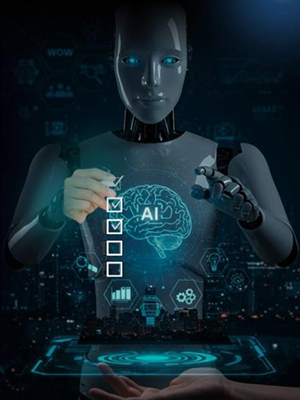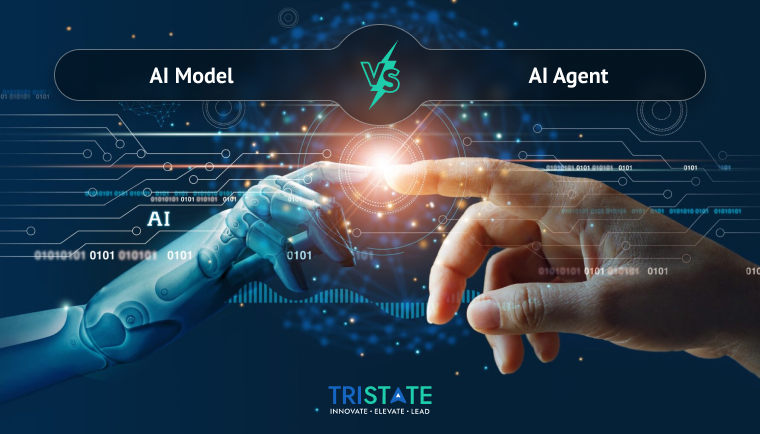
Terms like “AI agent” and “AI model” are frequently used interchangeably in the quickly developing field of artificial intelligence, which causes misunderstanding. But inside the AI ecosystem, both have different features. Anyone working on the creation, application, or deployment of AI must be aware of the distinction between an AI model and an AI agent.
In recent years, we have witnessed huge advancements in AI, particularly with the emergence of LLMs such as GPT-4, LLaMA, and Gemini. But AI is moving beyond conventional models to become AI agents as the need for more intelligent and autonomous systems increases. Although they both perform important tasks, their functions, capacities, and possible uses are very different.
To really appreciate AI’s potential and future, one must comprehend its distinctive features. While AI agents work independently in dynamic situations, completing tasks based on real-time information and modifying their behaviours as necessary, AI models are experts at analysing and interpreting data to provide insights or predictions. This article explores these distinctions and provides a thorough grasp of when to use an AI model vs an agent.
Table of Contents
What is an AI Models?
A mathematical framework created to carry out particular tasks by learning from data is basically what anAI model definitionis. To identify trends, provide forecasts, and offer insights, the models are defined using various datasets.
Artificial intelligence has evolved from research labs to practical business applications. While advanced AI models like ChatGPT have become well-known, machine learning models like Support Vector Machines (SVMs), neural networks, and decision trees are utilized extensively across industries. Businesses are increasingly hiring AI developers who can create, train, and optimize these models for a variety of applications, such as image recognition, natural language processing, fraud detection, and personalized recommendation systems, in order to remain competitive.
How do AI Models operate?
In order to produce predictions or judgments, AI models learn from data. They apply this knowledge to fresh, unknown data after using algorithms to find patterns and correlations in the original data. In AI model development, the process by which a model learns from a large dataset and adjusts its internal parameters to improve accuracy is called training.
Different Types of AI Models
1. Supervised learning
When a neural network uses labelled data sets to generate judgements or predictions, this is known as supervised machine learning. In order to educate the model to imitate human behaviour, the programmers have labelled the data sets, input key characteristics, and goal variables.
2. Unsupervised learning
Trend analysis, social media post sentiment grouping, traffic pattern recognition, and manufacturing process inefficiencies are some of the application cases for unsupervised learning models.
3. Reinforcement learning
An AI model is given a goal and then placed in a scenario where it must attempt to achieve the objective as part of the reinforcement learning approach. As it gains experience, the AI model improves its efficiency in achieving its objective.
Use Cases of an AI Model
1. Healthcare
AI efficiently evaluates CT images and X-rays, increasing the speed and precision of diagnosis for illnesses like TB and pneumonia. AI makes it possible to create personalised treatment regimens that maximize effectiveness and reduce adverse effects by evaluating genetic data, combining patient information, and applying predictive analytics.
AI can forecast illness risks, spot patterns and trends, and provide individualized preventative measures.
2. E-commerce and Retail
AI examines consumer preferences, past purchases, and behaviour to provide personalised product recommendations based on unique data. By displaying products according to personal preferences, this improves the shopping experience, raises consumer engagement, and increases sales.
Retailers can guarantee product availability and satisfy consumer expectations by precisely predicting demand. While preserving a flawless consumer buying experience, AI enables e-commerce systems to fight against changing fraudulent schemes.
3. Financial Services and Banking
By detecting transactions & highlighting possible theft activity, artificial intelligence (AI) is used in the finance industry to avoid breaches. The security of financial transactions is improved by machine learning algorithms. Response times are shortened, client contacts are streamlined, and customer satisfaction is increased because of this automation.
4. Real Estate
AI algorithms for real estate evaluate past data, regional market circumstances, and property characteristics to assess a property’s value. By automating processes, decreasing mistakes, and increasing productivity for individuals managing several rental properties, AI revolutionizes property management operations.
Pros of AI Models
- The Decrease in Human Error
Businesses often turn to Custom AI development services to gain more accurate and reliable outcomes. AI relies on algorithms and large datasets to make judgments at each stage, which helps limit errors. Although no system is flawless, rigorous programming and ongoing optimization can reduce mistakes to near-zero levels.
- Facilitates Better Decision-Making
Making decisions is one of AI’s well-known advantages. By using massive data to spot patterns and trends that are frequently missed by people, artificial intelligence (AI) improves decision-making. Businesses and people may swiftly and precisely make well-informed decisions because of machine learning algorithms’ ability to evaluate past data and forecast future events.
- Constant Access
According to several studies, people can be active for minimal hours, and they need time to balance their personal & professional life. Now, AI may function continuously. They can complete several jobs at once with precise outcomes and think far more quickly than humans.
Cons of AI Models
- Absence of Originality
The inherent creativity of humans, which results from emotional depth, abstract thought, and inventive processes, is sometimes absent from artificial intelligence (AI).
- Involves Privacy Issues
For AI systems to work well, enormous volumes of data are frequently needed, which raises serious privacy issues. The gathering, storing, and analysis of personal data can be invasive, disclosing private information without the agreement of the subjects.
What is an AI Agent
How Does an AI Agent Operate?
Usually, AI agent is designed to do particular tasks. They are made to assist you in some way, such as answering inquiries, scheduling appointments, or even handling your email inbox.
While AI agents excel at automating routine, uncomplicated activities, they lack the autonomy and decision-making skills of agentic AI. Imagine AI Agent/Copilot as your virtual assistants who follow your instructions without question.
Classification of AI Agents
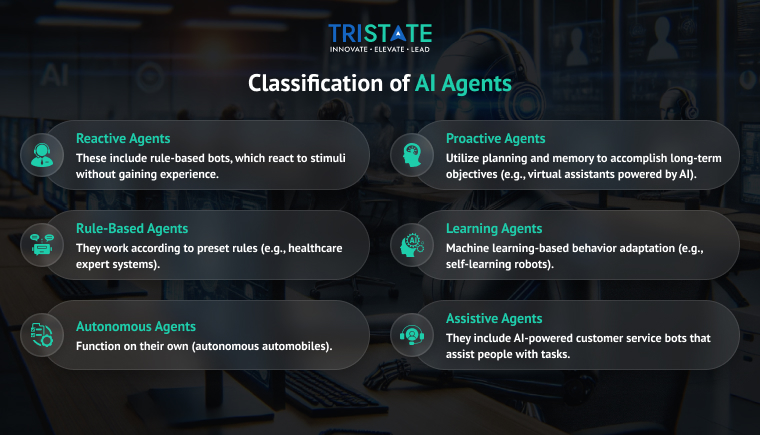
1. Agents that are Reactive versus Proactive
-
Reactive agents – These include rule-based bots, which react to stimuli without gaining experience.
-
Proactive Agents: Utilize planning and memory to accomplish long-term objectives (e.g., virtual assistants powered by AI).
2. Learning Vs. Rule-Based Agents
-
Rule-Based Agents- They work according to preset rules (e.g., healthcare expert systems).
-
Learning Agents – Machine learning-based behavior adaptation (e.g., self-learning robots).
3. Assistive vs. Autonomous Agents
-
Autonomous Agents– Function on their own (autonomous automobiles.
-
Assistive agents – They include AI-powered customer service bots that assist people with tasks.
Key Characteristics of AI Models
- Autonomy: An AI virtual agent can carry out tasks on its own without continual assistance or input from a human.
- Perception: Using a variety of sensors, including cameras and microphones, the agent function perceives and understands the environment in which it operates.
- Reasoning and decision-making: AI agents are clever instruments that are capable of data analysis and goal-achieving decision-making. They process information and behave appropriately by using algorithms and reasoning skills.
- Communication: AI agents may interact with people or other agents in a variety of ways, such as by comprehending and reacting to spoken language, identifying voice, and texting back and forth.
- Goal-oriented: They are made to accomplish particular objectives, which may be predetermined or discovered by interactions with the surroundings.
Use Cases of AI Agent
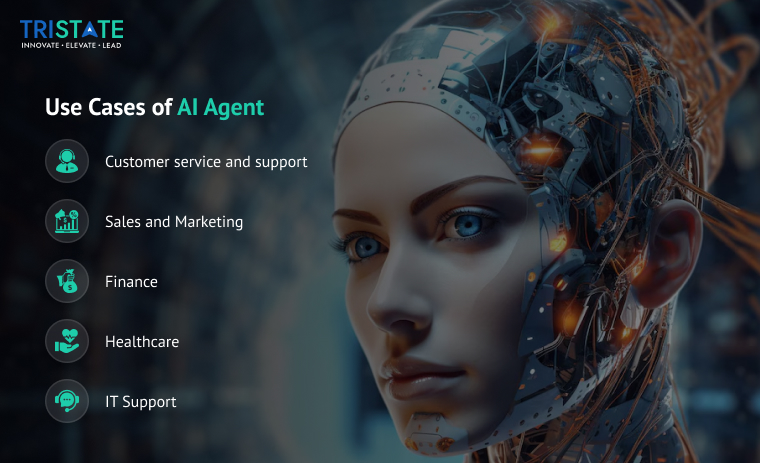
1. Customer service and support
AI agent use cases improve response times and customer satisfaction by answering routine questions, resolving simple problems, and referring more complicated issues to human agents. They may be used to automate conversations and offer round-the-clock assistance in contact centres, chatbots, and virtual assistants.
Providing order updates, responding to frequently asked questions, and helping with returns and refunds are a few examples.
2. Sales and Marketing
Benefits of AI agents include automating sales procedures, qualifying prospects, and customizing marketing campaigns. They are able to create focused marketing material, locate possible customers, and analyse consumer data.
AI agents may also help in cross-selling and upselling by using the customer’s past purchases and preferences.
3. Finance
AI systems automate processes, including loan processing, risk assessment, and fraud detection. They can detect financial data, detect patterns & give suggestions for investment plans. AI agents are being utilised for regulatory compliance and in robo-advisors.
4. Healthcare
AI agents help with drug administration, patient communication, and appointment scheduling. They are able to monitor patient health, assist with diagnosis, and analyse medical data. AI agents can also expedite administrative duties.
5. IT Support
AI agents take care of software upgrades, password resets, and simple troubleshooting. They can increase the effectiveness of IT assistance by automating problem response and service request fulfilment. Additionally, AI agents are capable of managing knowledge bases and offering insights into metrics related to IT assistance.
Key Differences between AI Models and AI Agents
An organized procedure with data intake, training, and producing predictions is how AI models work. The model is first fed raw data, which forms the basis for learning. In order to find patterns and connections, the model examines this data. This is during the training phase using ML algorithms & statistical data.When it comes to accuracy, this phase regularly involves improving the model’s limits using methods. After being trained, the AI model analyzes fresh data and uses the patterns it has discovered to produce predictions or insights.
From straightforward classifications, like identifying items in a picture, to intricate decision-making processes, like forecasting finances or natural language comprehension, these outputs can take many forms.
Whenthere is a difference between an AI model and an AI agent, AI agents may interact with their surroundings and change over time. This is because they work through a dynamic cycle of observation. It also includes decision-making and action execution. AI agents continually digest new information and modify their answers in contrast to fixed AI models that depend on pre-trained data.
The first step is perception, during which the agent uses cameras and sensors. This is for collecting data about its setting, and then this statistic is inspected to find trends, identify anomalies, or understand the background. The agent uses deep learning, reinforcement learning, or rules-based logic.
It is to drive its decision-making when it has a clear understanding of its surroundings. Making decisions frequently involves forecasting future conditions. The AI agent also weighs potential courses of action and chooses the best course of action based on predetermined objectives.
Prominent IT firms are influencing AI’s future by developing AI agents and models and using them in a range of real-world situations. Their methods draw attention to the differences between autonomous AI agents that engage in dynamic interactions with their surroundings and predictive AI models that provide insights.
How do AI Models & AI Agents collaborate in the Real World?
By constantly interacting with their surroundings and making judgments in real time, AI agents go beyond AI applications. One of the most sophisticated applications is in robotics and autonomous vehicles, where AI agents allow self-driving automobiles to safely traverse highways.
To ensure effective and secure navigation, these agents constantly scan sensor data through cameras, LiDAR, and GPS in order to identify impediments, decipher traffic signals, and make snap choices. In robotics, artificial intelligence (AI) agents manage industrial machines in manufacturing, streamlining production processes by adjusting to situations in real time. Chatbots or computer-generated assistants with AI competencies are another general use of AI agents.
AI agents are used by virtual assistants such as Siri, Alexa, and Google Assistant to process voice instructions, carry out tasks, and respond to user inquiries. NLP is used by chatbots in customer service to comprehend and effectively reply to consumer questions, minimizing human involvement and speeding up response times. These AI-powered assistants improve customer engagement and automate repetitive operations in industries like banking, healthcare, and retail.
AI agents are essential to cybersecurity, along with threat detection, because they can monitor network activity, identify security breaches, and react quickly to cyberthreats. To find malevolent trends, illegal access, and other security flaws, these agents examine enormous volumes of data.
When Agents and Models Cooperate
When AI models and agents are combined, hybrid AI systems are created, in which AI agents act on the insights from statistical analysis from AI models, and decision-making is informed by those insights. One important use case is in AI-driven systems for decision support, where AI agents make choices and AI models analyze big datasets to produce suggestions.
In the financial industry, for example, AI agents carry out trades according to preset methods, while AI models examine stock market patterns. AI models are used in healthcare to identify illnesses, and AI agents help with preparing for treatment, automating administrative work, and improving patient care.
Customized AI interactions in smart houses and the Internet of Things are another area where hybrid AI shines. To forecast ideal settings, AI algorithms examine user behavior and ambient factors. AI agents provide smooth automation, allowing customers to operate their homes with voice commands or smartphone applications, while smart assistants in Internet of Things devices, including thermostats, along with security systems, employ AI models providing data-driven insights.
Hybrid AI systems produce more intelligent, independent, and effective solutions across sectors by fusing the predictive power of AI models with the flexibility and immediate execution of AI agents. Businesses may fully utilize AI for innovation and expansion thanks to this synergy, which also improves user experience and decision-making.
Pick the right one for Your Project
Check how to choose between an AI model and an AI agent for apps-
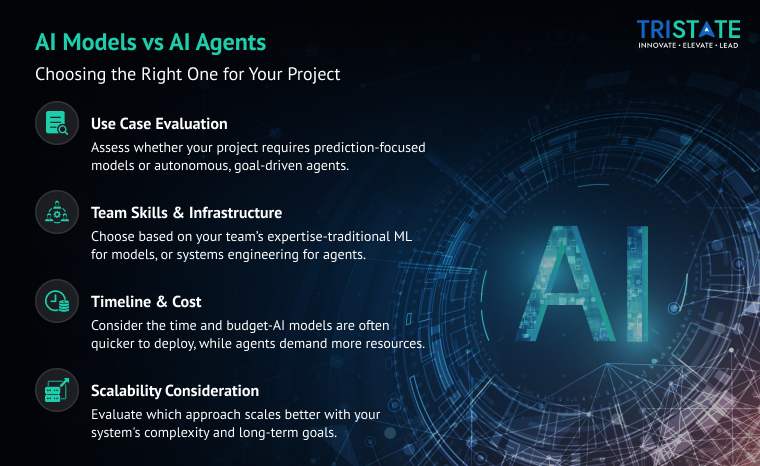
6.1 Use Case Evaluation
The intricacy and objectives of your project will determine whether you use AI models or AI agents. While AI agents are appropriate for independent decision-making and goal-oriented behaviors, AI models are best suited for tasks involving data analysis, estimation, and pattern recognition. To build the best app, it is vital to know the differences and significant factors for each.
6.2 Team Skills & Infrastructure
Analyze the AI model’s complexity in light of the tasks it must complete. Greater functionality could come from higher complexity, but more resources are needed as well. Make sure the AI agent performs well and produces the intended results after choosing the right one.
Make plans to integrate the AI model or agent with your current workflows and systems. Assure system compatibility and seamless data transfer.
6.3 Timeline & Cost
Once you’ve got a clear grasp of your objectives and goals, the following step is to examine the various possibilities and pick the most appropriate AI agent type. Think about how much it will cost to create, implement, and maintain the AI agent. Generally speaking, more sophisticated agents are more expensive.
Utility-based agents are appropriate for high-stakes purposes like financial trading since they may be expensive to build and operate, despite their potential for great performance.
6.4 Scalability Consideration
Evaluate the AI agent’s scalability. Can it adjust to new duties or manage a boost in workload without undergoing major changes? For applications like adaptive learning systems that change over time, goal-based agents may be more scalable.
AI Models and AI Agents Trends to Watch in the Future
The remarkable AI agents of today are already supporting site reliability teams with system debugging, helping software developers create code, and doing a wide range of analytical activities. Even so, we are only just starting to see the full extent of these specialized agents’ capabilities.
With capabilities that will revolutionize our work in a wide range of disciplines, the next wave of changes is rapidly arriving. AI agents stand to develop increasingly more prominently in human existence in the future. These intellectual systems are emerging quickly, and some captivating designs are starting to emerge.
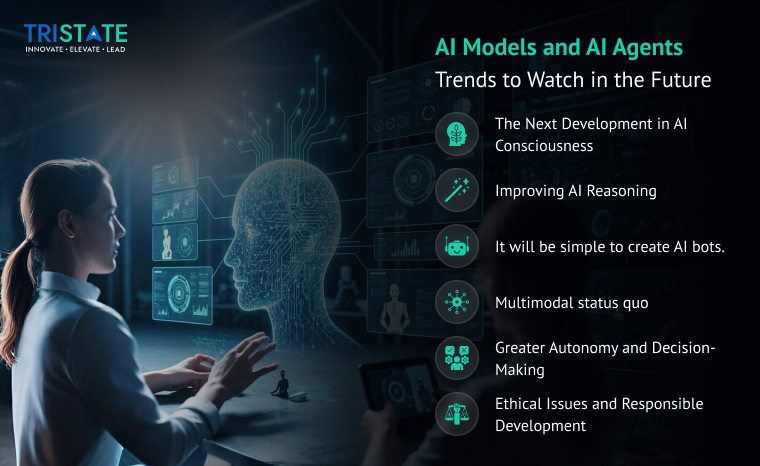
1. The Next Development in AI Consciousness
Reflection enables an AI agent to review its previous acts, analyze their outcomes, and modify its behavior in subsequent circumstances. This suggests that by applying the lessons it has learnt from different circumstances, it can increase its efficacy.
2. Improving AI Reasoning
Since they solely employ trained algorithms to produce reactions or actions to immediate inputs, the majority of AI agents now in use are reactive. Artificial intelligence (AI) agents must be able to reason in several steps, often known as the chain of thought, as systems get more intricate and advanced.
3. It will be Simple to Create AI bots
AI bots are becoming more intelligent as a result of developments like deep learning and NLP. However, it is no longer limited to tech specialists. While no-code platforms like Bizway and Lyzr enable anybody to create AI agents without knowing any code, tools like Lang Chain and Auto-Gen offer user-friendly interfaces. Cloud computing also helps by providing data and power that are easily available. This change is surprisingly enabling small enterprises and single entrepreneurs to generate new ideas in unexpected places.
4. Multimodal Status Quo
By 2034, the promising part of multimodal AI can undergo widespread testing and development. Unimodal AI focuses on a single kind of record, such as NLP. Multimodal type of AI, on the other hand, learns insights from voice, facial expressions, and verbal inflections. It is more thoroughly imitating human communication. To enable more normal communications between humans and computers, this knowledge will integrate text, verbs, images, videos, and additional data. Progressive chatbots and VAs that can understand complex studies and reply with modified text, VAs, or video sequences might be driven by it.
5. Greater Autonomy and Decision-Making:
AI agents will grow increasingly independent, able to plan projects, finish work with little assistance from humans, and make more choices on their own.
This is the capacity to examine information, spot trends, and reach well-informed conclusions based on context and supporting facts. According to Gartner, 33% of business software applications will use agentic AI by 2028, a major growth in the use of AI to make choices in day-to-day work.
6. Ethical Issues and Responsible Development:
It’s critical to address ethical issues like bias, accountability, and transparency as AI agents grow in strength. It will be crucial to create strong frameworks for dealing with potential biases and preserving openness in AI decision-making procedures.
Summary
AI models, along with AI agents, have different but complementary functions. While AI agents offer autonomy and flexibility, AI consulting services for AI models are excellent at data analysis and prediction. Both will be integrated into the future of AI to create more intelligent and self-sufficient systems that improve productivity across sectors.
Many AI model and agent developers can assist if your company wants to successfully deploy models based on AI or AI agents. In vast industries, our AI specialists offer customized AI solutions that guarantee peak performance and smooth integration. Hope the above content is enough to help you decide which is better: AI model or AI agent for businesses.





